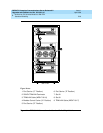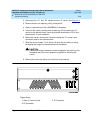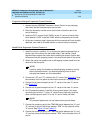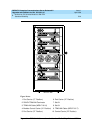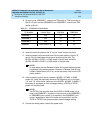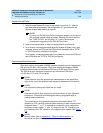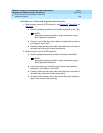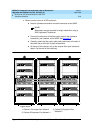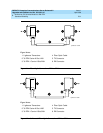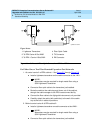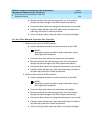
DEFINITY Enterprise Communications Server Release 8.2
Upgrades and Additions for R8r
555-233-115
Issue 1
April 2000
Multicarrier G2 Universal Module to R8r EPN
5-27Standard Reliability
5
Collocated Port Networks
For a standard reliability system with 1 collocated EPN, use 1 fiber optic cable
and 2 lightwave transceivers to directly connect the networks.
For a standard reliability system with 2 collocated EPNs, use 3 fiber optic cables
and 6 lightwave transceivers to directly connect the networks.
NOTE:
Based on floor-plan considerations, the length of these cables may vary.
20 foot (6.1 m) cables are normally adequate for a Release 8 with 2 port
networks.
For collocated cabinets, route the fiber optic cables directly from the PPN to the
EPN cabinet. If a “DEFINITY style” PPN cabinet is collocated with another
“DEFINITY style” EPN cabinet, the preferred routing is to run the cables
up
the
cable tray and out the top of the PPN cabinet. The cables are then run to the
other cabinet, through the top of the cabinet, and down the cable tray to the
desired carrier level.
If a “DEFINITY style” PPN cabinet is collocated with either a small cabinet,
medium cabinet, or single-carrier cabinet stack, the preferred routing is to run the
cables
down
the cable tray and out the bottom of the PPN cabinet. The cables
are then run to the EPN cabinet and up the outside of the rear panels to the
desired carrier level.
Fiber-Remoted Port Networks
For a standard reliability system with 1 fiber-remoted EPN, use 2 fiber optic
cables, 2 lightwave transceivers, and 2 lightguide interconnect units (provided
by the PSC).
For a standard reliability system with 2 fiber-remoted EPNs, use 6 fiber optic
cables, 6 lightwave transceivers, and 6 lightguide interconnect units (provided
by the PSC).
For fiber-remoted cabinets, route the cables down the cable tray and out the
bottom of the cabinet to the MDF where the lightguide interconnect units are
located.
In either case, use cable ties to secure the cable against the walls of the cable
tray at the cable tie positions built into the trays.




